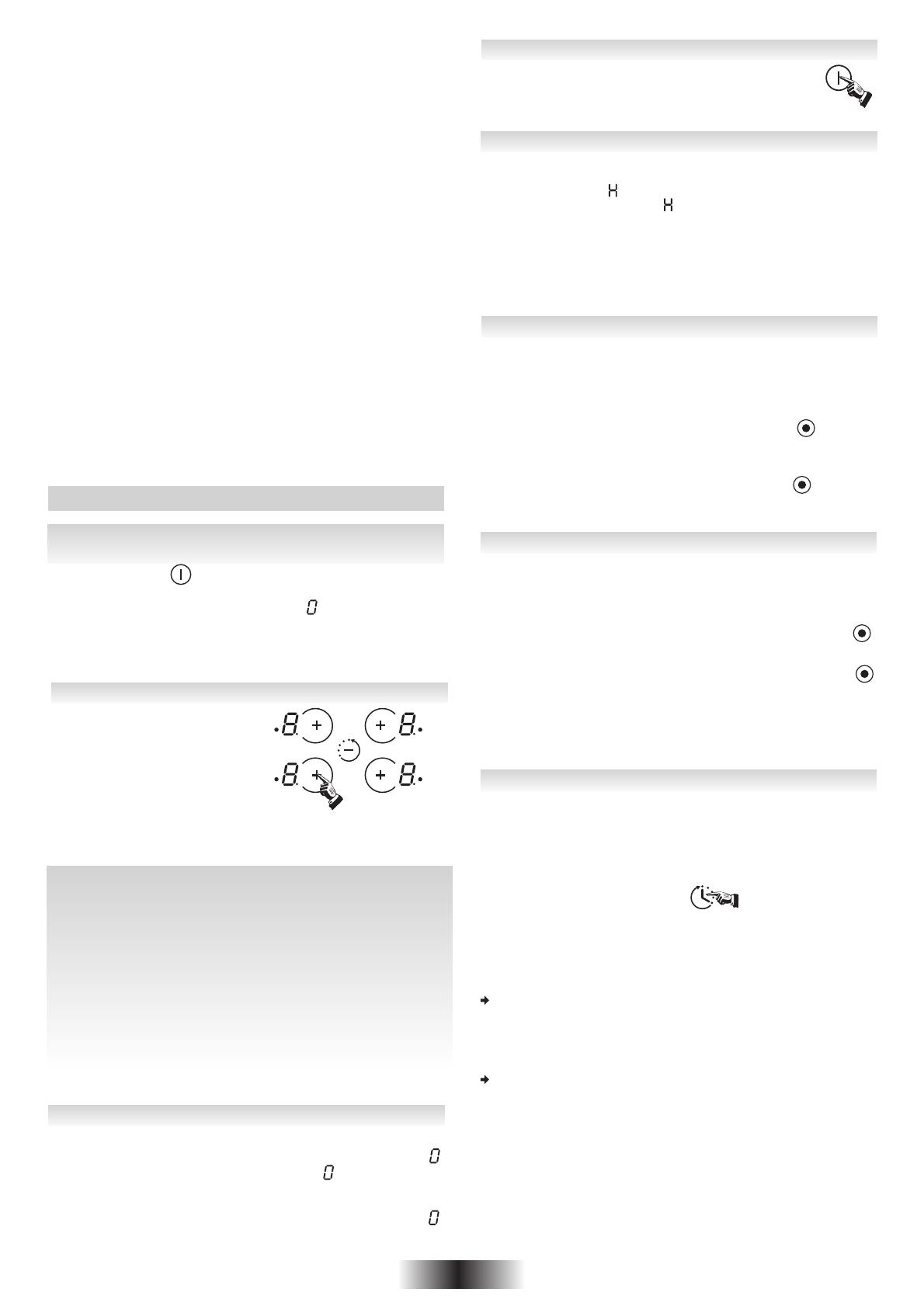
LE CHOIX DES RECIPIENTS - Les informations suivantes vous
aideront à choisir les récipients les mieux adaptés pour obtenir
de bons résultats.
Inox : conseillé.
Spécialement bon avec fond "Sandwich". Le fond "Sandwich" allie
les qualités de l'inox (aspect, durabilité et stabilité) avec les
avantages de l'aluminium ou cuivre (transmission de la chaleur
et répartition uniforme).
Aluminium : fond épais recommandé. Bonne conductivité.
Attention : les résidus d'aluminium apparaissent quelquefois
sous forme de traces sur la table, mais peuvent être enlevés si
ils sont nettoyés rapidement. L'aluminium de faible épaisseur ne
doit pas être utilisé.
Fonte / Vitrocéramique : déconseillé.
Faible performance. Peut rayer la surface.
Fond en cuivre : fond épais recommandé.
Bonne performance, mais le cuivre peut laisser des traces qui
peuvent apparaître comme des rayures. Elles peuvent être enlevées
si la table est nettoyée rapidement.
Cependant, ne pas laisser évaporer l'eau des récipients
complètement, le métal surchauffé peut adhérer à la surface. Un
récipient en cuivre surchauffé peut laisser des traces qui risque
de tacher définitivement la table.
Porcelaine / Acier émaillé : bonne performance.
Seulement avec fond plat, peu épais et lisse.
18 FR
7. UTILISATION
- Presser la touche - ou + pour choisir un niveau de puissance
entre 1 et 9. En maintenant la pression sur la touche + ou -,
le niveau de puissance augmente ou diminue progressivement.
Les exemples suivants sont donnés à titre indicatif. L'expérience
personnelle permet ensuite d'adapter ces réglages aux goûts et
aux habitudes de chacun.
0 : Arrêt
1 : )
2 : ) ..... Fondre
3 : Maintien de la chaleur
4 : Réchauffage
5 : Décongélation, cuisson à l'étuvée, cuisson à
point, cuisson à faible température
6 : Cuisson sans couvercle
7 : Sautés, rissolés de viande et rôtis
8 : Cuissons et rôtis à haute température, saisir
9 : Friture, portée à ébullition de grandes quantités
d'eau.......
• ARRET D’UN FOYER DE CUISSON
- Presser la touche de sélection du foyer désiré.
- Presser la touche - jusqu'à afficher le niveau de puissance .
Instantanément le foyer s'éteint, l'indication s'efface après 10
secondes.
- Pour un arrêt rapide, appuyer simultanément sur la touche - et
+. Le niveau de puissance redescend automatiquement à .
Le foyer s'éteint.
• Après la mise sous tension de la table, attendre quelques
secondes pour activer les commandes électroniques
- Presser la touche .
La commande électronique de la table est activée. Dans chaque
zone d'affichage le niveau de puissance s'affiche et la diode
de commande clignote.
- Sans intervention dans les 20 secondes, la commande
électronique s'éteint et l'opération de mise en route doit être
renouvelée.
• ACTIVATION D’UN FOYER DE CUISSON
- Presser la touche de sélection
du foyer désiré. Dans la zone
d'affichage, la diode de com-
mande devient fixe. Elle indique
que la zone est active.
• ARRET GENERAL
Le fonctionnement des foyers et de la minuterie peut
être stoppé à tout moment par une pression sur la touche
Marche-Arrêt.
Le foyer deux zones équipe certains modèles de table. Il peut
être en forme concentrique ou extensible.
Il s'active dans sa totalité lorsque le foyer correspondant est
mis en fonctionnement; la diode du foyer complémentaire
s'affiche.
Pour désactiver le foyer complémentaire :
- Appuyer sur la touche "Fonction complémentaire" . La diode
correspondante au foyer complémentaire s'éteint lorsque ce
foyer est désactivé.
Pour réactiver le foyer complémentaire :
- Appuyer sur la touche "Fonction complémentaire" . La diode
correspondante au foyer complémentaire s'affiche lorsque ce
foyer est activé.
Le foyer trois zones équipe un modèle de table.
Il s'active dans sa totalité lorsque le foyer est mis en fonctionnement.
Les deux diodes du foyer complémentaire sont affichées.
Pour désactiver les foyers complémentaires :
- Appuyer une fois sur la touche "Fonction complémentaire" .
La diode correspondante au foyer extérieur s'éteint lorsque ce
foyer est désactivé.
- Appuyer deux fois sur la touche "Fonction complémentaire" .
La diode correspondante au foyer central s'éteint lorsque ce
foyer est désactivé.
Pour réactiver les foyers complémentaires, procéder de la
même façon que celle citée précedemment avec un ou deux
appuis sur la fonction complémentaire, selon besoin.
• INDICATEUR DE CHALEUR RESIDUELLE
Le tableau de commande informe l'utilisateur lorsque la température
de surface des zones de cuisson dépasse 60°C environ, par
l'affichage suivant : . Lorsque la température redescend en
dessous de 60°C, l'affichage s'efface.
Pour les fins de cuisson, nous conseillons d'éteindre la zone de
cuisson et de profiter de la chaleur résiduelle du foyer de cuisson
pour terminer la cuisson en douceur.
N.B. : après coupure de courant, l'indicateur de chaleur résiduelle
disparaît définitivement et ce, même si la température de surface
dépasse 60°C.
• FONCTIONNEMENT DU FOYER DEUX ZONES
• FONCTIONNEMENT DU FOYER TROIS ZONES
Chaque foyer de cuisson est programmable pour une durée
maximale de 99 minutes.
- Mettre en route le foyer désiré en répétant les opérations citées
précédemment.
La diode de commande près du niveau de puissance doit être
affichée, elle indique que le foyer est actif.
- Appuyer sur la touche Minuterie
Le répère de foyer autour de l'affichage du minuteur rappelle le
foyer commandé.
- Réappuyer sur la touche "Minuteur" pour choisir une durée en
minutes de 0 à 99 minutes ou appuyer sur la touche " - " pour
diminuer le temps de 60 minutes à 0.
le temps programmé peut être modifié à tout moment en
réactivant le foyer et la touche de sélection du minuteur.
Une fois le temps écoulé, le foyer de cuisson s'éteint
automatiquement et un bip sonore retentit appuyer sur la touche
"Minuteur" pour le stopper.
Le minuteur peut être utilisé seul comme aide mémoire, une
sonnerie retentira à la fin du temps programmé.
• PROGRAMMATION D’UN FOYER DE CUISSON (selon modèle)



















